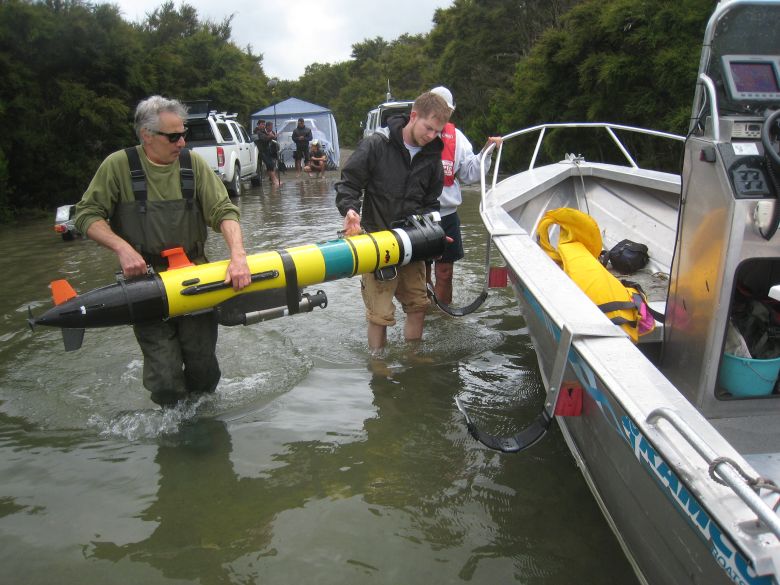Century-old eruption mystery solved by US and NZ scientists
28 May 2024 | news
The second in a series of articles to commemorate 150 years of formal scientific partnership between New Zealand and the United States.
The following article is courtesy of Science NZ and GNS Science.

US scientists loading an autonomous underwater vehicle (AUV) onto a support boat for a day-long mission mapping the lake floor of Lake Rotomahana. Photo credit: Julian Thomson, GNS Science.
Nearly a decade has passed since New Zealand and American scientists solved the mystery of what happened to the Pink and White Terraces after the eruption of Mount Tarawera, southeast of Rotorua, 138 years ago.
The Terraces, on the edge of Lake Rotomahana, had been described as the eighth wonder of the world and had attracted tourists from many countries.
But they disappeared on the night of the eruption which resulted in the deaths of 120 people. It was presumed the Terraces were completely destroyed in a blast so big it was heard in the South Island.
Before the eruption, Lake Rotomahana was only about 20 percent of its present size.
As a result of the eruption the previous lake outflow was dammed, and over time it filled with water and formed the new Lake Rotomahana, much larger and deeper than the original.
The eruption – the most destructive in New Zealand for at least 200 years – resulted in half a cubic kilometre of lakefloor material ejected from the lake and splattered on the surrounding landscape.
Given that the eruption left a 17km-long gash through Mount Tarawera and beneath the lake, the notion that the Terraces were destroyed was perhaps not surprising.
The research, led by GNS Science and its partner Woods Hole Oceanographic Institution in the United States, was driven partly out of scientific curiosity and partly by the desire to clear up long-lasting uncertainties about the eruption and its impact on the lake and the Terraces.
It assembled some of the most sophisticated technology available - including side-scan sonar, seismic survey and mapping equipment, heat-flow measuring equipment, magnetic anomaly testing gear, and underwater photography - to probe the lake and reconstruct what happened during the eruption and the following months.
The combined power of these techniques enabled scientists to make many interesting interpretations of what actually happened on the day of the eruption and in the weeks and months that followed.
In effect, the technology stripped away not only the lakewater, but also the thick lakefloor sediment too.
A highlight was the discovery of remnants of the Pink Terraces sitting below the lake surface. The neighbouring White Terraces were not so lucky and appear to have been destroyed.
There were two slightly less celebrated discoveries that were just as exciting for the scientists. The first was an extensive body of magma sitting below the lake. At its shallowest, the magma body is within about 2km of the Rotomahana lakefloor. Its deepest extent is less clear, but it might extend down as far as 6km below the lake.
The magma body explains why there are large amounts of heat and gas coming into the present-day lake – the second discovery. The amount of heat coming out of the lakefloor – estimated at between 110 and 130 megawatts (MW) - is equivalent to the output of a typical geothermal power station in the Taupō region.
The multi-year study by US and New Zealand scientists was the most thorough investigation of the lake to date. It has given the clearest view yet into how the Mt Tarawera eruption in 1886 forever transformed Lake Rotomahana and laid waste to the world-famous tourist attraction at its edge.
GNS Science wishes to thank Woods Hole Oceanographic Institution in the United States, the University of Waikato, the Te Arawa Lakes Trust Board, tourism operator Waimangu Volcanic Valley, and the Bay of Plenty Regional Council for their assistance in this project.
